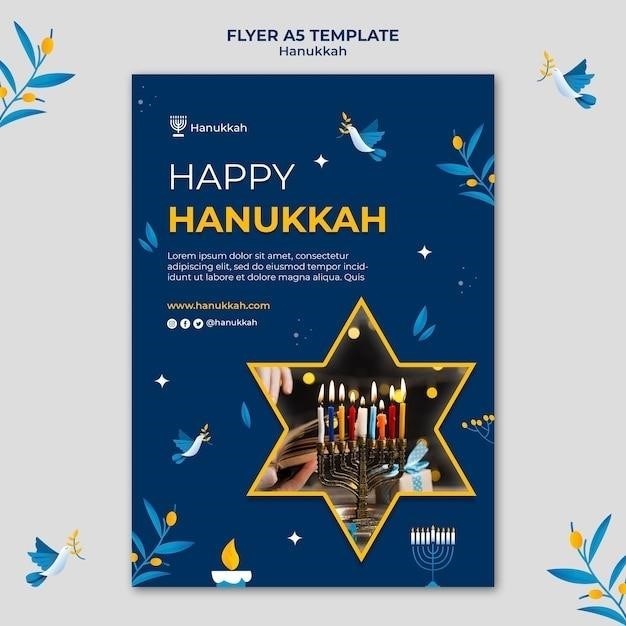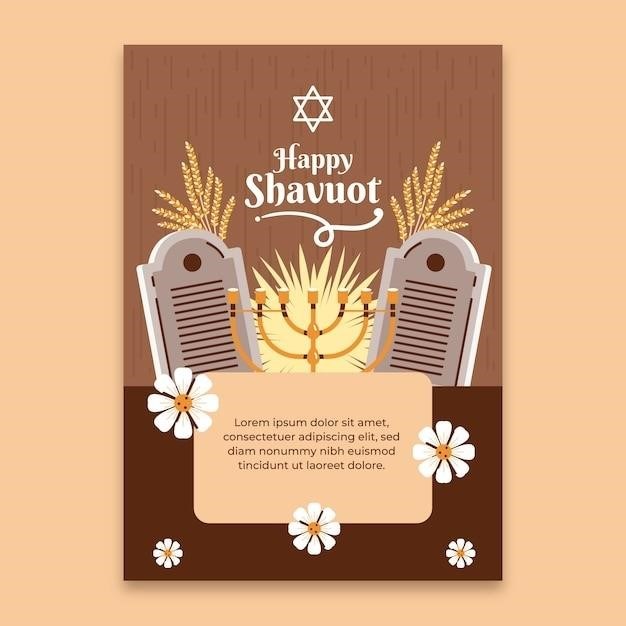Siddur Lev Shalem⁚ A Comprehensive Guide
This guide explores the Siddur Lev Shalem, a prayer book used by Conservative Judaism, offering insights into its history, key features, translations, and availability.
Introduction
The Siddur Lev Shalem, meaning “Siddur of Wholeheartedness,” is a prayer book designed for Shabbat and festival services within the Conservative Jewish movement. It represents a significant contribution to contemporary Jewish liturgical literature, aiming to bridge the gap between traditional prayer practices and the evolving needs of modern Jewish life. This comprehensive guide delves into the Siddur Lev Shalem’s history, development, key features, and its role in contemporary Conservative Judaism. We will explore the innovative translations, transliterations, and commentaries that make this prayer book a unique and enriching resource for Jewish prayer.
The Siddur Lev Shalem has been praised for its accessibility, inclusivity, and its commitment to enriching the Jewish prayer experience. It offers multiple pathways into prayer, reflecting the Conservative movement’s commitment to authenticity and responsiveness to the evolving concerns of its members. The prayer book features a four-column format, contemporary language translations, and a commentary that provides historical context and kavanot, or intentions, for prayer. This comprehensive approach encourages deeper engagement with the text and a more meaningful connection to Jewish tradition.

Overview of Siddur Lev Shalem
The Siddur Lev Shalem is a comprehensive prayer book designed for Shabbat and festival services within the Conservative Jewish movement. It is a product of the Rabbinical Assembly, the professional organization of Conservative rabbis, and reflects the movement’s commitment to maintaining a balance between tradition and modernity. The Siddur Lev Shalem stands out for its innovative approach to Jewish prayer, incorporating contemporary language translations, transliterations, and commentary to make the texts accessible and meaningful to a wider audience.
The Siddur Lev Shalem presents a unique four-column format, which allows for a rich and layered engagement with the prayers. The first column features the Hebrew text, while the second provides a transliteration, making it easier for those unfamiliar with Hebrew to follow along. The third column offers a clear and contemporary English translation, ensuring accessibility and understanding. Finally, the fourth column presents a commentary, providing historical context, theological insights, and kavanot (intentions) for prayer. This multi-faceted format fosters a deeper understanding of the prayers and their significance within Jewish tradition.
History and Development
The Siddur Lev Shalem emerged from a long-standing need within Conservative Judaism for a prayer book that reflected the movement’s evolving perspectives and sensibilities. The development of the Siddur Lev Shalem was a collaborative effort, drawing upon the expertise of a dedicated committee of rabbis, cantors, and scholars. This committee, led by Rabbi Edward Feld as Senior Editor and Chair, and Rabbi Jan Uhrbach as Associate Editor, worked diligently to ensure that the Siddur reflected the richness and diversity of Conservative Jewish thought and practice.
The Siddur Lev Shalem builds upon the legacy of previous Conservative prayer books, most notably the Siddur Sim Shalom, which was published in 1998. While acknowledging the value of these earlier works, the Siddur Lev Shalem committee aimed to create a new and original translation, drawing upon contemporary scholarship and reflecting the changing needs of the Conservative Jewish community. This process involved careful consideration of the Hebrew text, the English translations, and the inclusion of commentary that provided deeper insights into the prayers and their meaning.
Key Features of the Siddur
The Siddur Lev Shalem stands out for its innovative approach to prayer, offering a comprehensive and engaging experience for Conservative Jews. One of its defining features is its four-column format, which allows for a multi-layered understanding of the prayers. The first column presents the traditional Hebrew text, while the second column offers a new translation in contemporary language, making the prayers accessible to a wider audience. The third column provides a commentary that delves into the historical context of the prayers, offering insights into their development and meaning. Finally, the fourth column features a collection of kavanot, poetry, and prose, enriching the prayer experience with diverse perspectives and spiritual reflections.
The Siddur Lev Shalem also emphasizes the importance of transliteration, providing a guide for pronunciation that assists those unfamiliar with Hebrew. This feature makes the Siddur more inclusive and accessible to those who may not be fluent in Hebrew. The Siddur also incorporates a wide range of musical settings, allowing for diverse musical expressions within the prayer service. By offering multiple pathways into the Jewish prayer experience, the Siddur Lev Shalem encourages personal engagement with the text and fosters a deeper connection to Jewish tradition.
Translations and Transliterations
The Siddur Lev Shalem places a strong emphasis on providing clear and accessible translations and transliterations, recognizing the need to bridge the gap between the traditional Hebrew text and contemporary understanding. The Siddur features new translations in contemporary language, aiming to make the prayers relevant and relatable to modern readers. These translations strive to capture the essence and nuances of the original Hebrew, while employing clear and concise language that avoids archaic expressions.
In addition to the translations, the Siddur includes comprehensive transliterations, offering a guide to pronunciation that helps individuals unfamiliar with Hebrew navigate the text. This feature is particularly valuable for those who may not have prior knowledge of Hebrew, allowing them to participate fully in the prayer service. The transliterations are presented alongside the Hebrew text, providing a visual aid for pronunciation and enhancing the overall accessibility of the Siddur.
The Siddur Lev Shalem’s commitment to clear translations and transliterations reflects a desire to make Jewish prayer accessible to a broader audience, fostering inclusivity and encouraging deeper engagement with the rich tradition of Jewish liturgy.
Commentary and Kavanot
The Siddur Lev Shalem goes beyond simply presenting the prayers; it provides insightful commentary and kavanot (intentions) to enrich the prayer experience. The commentary offers historical context, exploring the origins and evolution of the prayers, shedding light on their deeper meaning and significance. It delves into the theological and philosophical underpinnings of the prayers, helping readers understand the underlying principles and beliefs that inform them.
Kavanot, included alongside the prayers, provide a framework for personal reflection and intentionality. These brief reflections offer guidance on how to approach each prayer with focus and purpose, encouraging deeper engagement with the text. The kavanot provide a way to connect with the prayers on a personal level, allowing individuals to personalize their prayer experience and infuse it with their own thoughts and feelings.
The combination of commentary and kavanot creates a rich and multifaceted approach to prayer, encouraging a deeper understanding of the liturgy and fostering a more meaningful connection to the tradition. It empowers individuals to engage with the prayers intellectually and emotionally, enriching their prayer experience and deepening their spiritual practice.
Use in Conservative Judaism
The Siddur Lev Shalem has become a central prayer book within Conservative Judaism, reflecting the movement’s commitment to balancing tradition and modernity. Its widespread adoption signifies the movement’s embrace of contemporary language and perspectives while maintaining fidelity to Jewish tradition. The Siddur Lev Shalem’s inclusion of both traditional and modern elements caters to the diverse needs and preferences of Conservative Jews, ensuring a prayer experience that is both meaningful and relevant to their lives.
Its use in Conservative synagogues and by individual practitioners underscores its significance as a resource for prayer and spiritual growth. The Siddur Lev Shalem’s comprehensive nature, encompassing both Shabbat and festival services, makes it a valuable tool for both communal and personal prayer. Its accessibility and user-friendliness have contributed to its popularity, encouraging wider participation in prayer and fostering a deeper connection to Jewish tradition.
The Siddur Lev Shalem embodies the spirit of Conservative Judaism, striving to bridge the gap between tradition and contemporary life. It provides a framework for prayer that resonates with the values and concerns of modern Jews, while grounding them in the rich heritage of Jewish tradition. Its continued use within Conservative Judaism is a testament to its enduring relevance and its ability to connect generations of Jews to the power and beauty of prayer.
Availability and Download Options
The Siddur Lev Shalem is readily available through various channels, catering to the diverse needs of its users. Printed copies can be purchased from online retailers such as Amazon, as well as from Jewish bookstores and synagogue gift shops. The Rabbinical Assembly, the organization responsible for its publication, offers direct purchase options on its website, making it easily accessible to individuals and congregations.
For those seeking digital access, the Siddur Lev Shalem is available in PDF format, allowing for convenient download and offline use. While the Rabbinical Assembly previously offered free digital downloads, they have since transitioned to a subscription-based model, providing access to a comprehensive library of prayer books and resources. This shift reflects the evolving nature of digital content distribution and the need to sustain the ongoing development and maintenance of these resources.
Additionally, various websites and platforms offer downloadable versions of the Siddur Lev Shalem, often for free. These options provide accessibility to those who may not have access to printed copies or prefer digital formats. It is important to note that the availability and legality of these downloads may vary, and users should exercise caution when sourcing digital content from unfamiliar sources.
Siddur Lev Shalem Committee
The Siddur Lev Shalem is the product of a dedicated committee of prominent Conservative Jewish scholars, rabbis, and cantors. Led by Senior Editor and Chair, Rabbi Edward Feld, the committee convened to create a contemporary and inclusive prayer book that reflected the evolving needs and values of Conservative Judaism. This collaborative effort brought together diverse perspectives and expertise, ensuring that the Siddur Lev Shalem was a product of careful deliberation and consensus.
The committee’s membership reflects the breadth and depth of Conservative Jewish thought and practice. It includes prominent figures such as Rabbi Jan Uhrbach, Associate Editor, Rabbi David M. Ackerman, Hazzan Joanna Dulkin, Rabbi Amy Wallk Katz, Rabbi Cantor Lilly Kaufman, Rabbi Alan Lettofsky, Rabbi Robert Scheinberg, and Rabbi Carol Levithan, ex officio. This diverse group of scholars, rabbis, and cantors brought their unique perspectives and experiences to the project, ensuring that the Siddur Lev Shalem was a truly representative and inclusive prayer book. The committee’s commitment to creating a meaningful and accessible prayer experience for all Conservative Jews is evident in the Siddur Lev Shalem’s comprehensive content and its contemporary language.
Notable Contributors
The creation of the Siddur Lev Shalem was a collaborative effort, drawing upon the expertise and insights of numerous individuals who contributed their talents to ensure the project’s success. Beyond the dedicated members of the Siddur Lev Shalem Committee, several notable figures played key roles in shaping the prayer book’s content and structure.
Hazzan Sarah Alexander, a renowned cantor and scholar, crafted the original translations and transliterations for the Siddur Lev Shalem. Her work reflects a deep understanding of the Hebrew language and a commitment to making the prayers accessible and meaningful for contemporary Jewish worshipers. The Rabbinical Assembly, the organization representing Conservative Jewish rabbis, generously contributed selected Hebrew prayers and English readings from the Siddur Lev Shalem, further enriching the prayer book’s content and ensuring its alignment with Conservative Jewish tradition.
The Siddur Lev Shalem stands as a testament to the collective efforts of these dedicated individuals. Their contributions have helped create a prayer book that is both faithful to tradition and responsive to the needs of contemporary Conservative Jews. The Siddur Lev Shalem’s enduring popularity speaks to the impact of these notable contributors and their commitment to enriching Jewish prayer for generations to come.
Comparison with Other Siddurim
The Siddur Lev Shalem occupies a unique position within the landscape of Jewish prayer books, distinguishing itself from other Siddurim through its distinct approach to translation, commentary, and overall design. While drawing inspiration from earlier works like the Siddur Sim Shalom, the Lev Shalem offers a fresh perspective on traditional Jewish prayers, reflecting the evolving needs and perspectives of contemporary Conservative Judaism.
One significant difference lies in the Siddur Lev Shalem’s emphasis on contemporary language and accessibility. Unlike some traditional Siddurim that retain archaic language, the Lev Shalem strives to present the prayers in a clear and engaging manner, making them more readily comprehensible for modern readers. The inclusion of comprehensive commentary, historical context, and kavanot (intentions) further enhances the prayer experience, providing deeper insights into the meaning and significance of the text.
Moreover, the Siddur Lev Shalem’s innovative four-column format distinguishes it from other Siddurim. This design allows for a seamless integration of the Hebrew text, English translation, commentary, and additional resources, creating a user-friendly experience that encourages deeper engagement with the prayers. This unique combination of contemporary language, insightful commentary, and user-friendly design sets the Siddur Lev Shalem apart, providing a distinct and enriching approach to Jewish prayer for Conservative Jews.
Reception and Reviews
The Siddur Lev Shalem has received a generally positive reception from both the Conservative Jewish community and scholars of Jewish liturgy. Reviewers have commended its contemporary language, insightful commentary, and user-friendly format. The siddur has been praised for making traditional prayers accessible to a wider audience while offering a fresh perspective on Jewish prayer for those familiar with traditional texts.
Many reviewers have highlighted the siddur’s comprehensive commentary, which provides historical context, theological insights, and practical guidance for prayer. They have also noted the inclusion of kavanot, which offer suggestions for intentions and meditations to enhance the prayer experience. The siddur’s four-column format has been lauded for its clarity and user-friendliness, making it easy for individuals to navigate the text and engage with its various elements.
Some reviewers have observed that the siddur’s focus on contemporary language and inclusivity may not resonate with all members of the Conservative Jewish community. However, the overall reception of the Siddur Lev Shalem has been positive, with many praising it as a significant contribution to Jewish prayer literature and a valuable resource for Conservative Jews seeking a meaningful and enriching prayer experience.
The Siddur Lev Shalem stands as a testament to the Conservative movement’s commitment to innovation and inclusivity within Jewish prayer. It offers a contemporary approach to traditional Jewish liturgy, making it accessible to a wide range of individuals while maintaining the richness and depth of the Jewish prayer tradition. Its insightful commentary, diverse range of translations, and user-friendly format have been praised by both scholars and practitioners alike.
The siddur’s emphasis on accessibility and inclusivity reflects the evolving needs and concerns of the Conservative Jewish community. It provides a framework for meaningful prayer that resonates with individuals across generations and backgrounds. Whether used in a synagogue setting or for personal prayer, the Siddur Lev Shalem offers a valuable resource for deepening one’s connection to Jewish tradition and engaging in a meaningful and enriching prayer experience.
As the Conservative movement continues to evolve, the Siddur Lev Shalem serves as a valuable resource for navigating the complexities of contemporary Jewish life and finding meaning in traditional prayers. Its enduring popularity speaks to its ability to connect with individuals seeking a meaningful and authentic prayer experience within the framework of Conservative Judaism.




